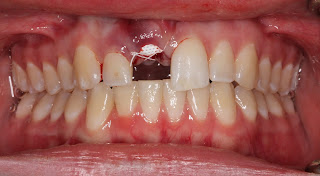Implant Workup:
PMH:
Healthy
Smoker: No
Diabetic: No
Periodontal Disease: No
Radiation/Bisphophonate use: No
Restorative Plan:
Single fixed
fixed bridge
Implant supported overdenture
Fixed Hybrid
Hard tissue:
Vertical: 15 mm from ridge to nasal floor
Horizontal: 5 mm ridge width
Interdental space: sufficient incisor width
Active infection: Yes
Grafting: socket preservation, gap grafting, veneer graft, guided bone regeneration
Soft Tissue:
Biotype: Thin
Keratinized tissue: 3 mm on buccal, stable
Recession: no
Grafting: subepithelial CTgraft, free gingival graft, rotational flap, none
Smile Line: High, Low, N/A
Treatment Plan
Two Stage
Single Stage
Immediate
Implant: #9 BioMet tapered platform switch 3.5 x13mm
Narrative:
This young women was referred for extraction and implant tooth #8. The tooth had internal resorption and had a root canal over a year previously. The resorption continued until the tooth was deemed non-restorable and had a buccal parulus. The decision was made to extract the tooth and perform socket preservation due to the active infection. The patient was previously on antibiotics and had no purulence on the day of surgery. After 4 months healing a CT scan was taken which showed the residual ridge had only 5 mm of facial-palatal width. She also had a high smile line and very thin gingival biotype. On the day of surgery, a mid crestal incision was made and a split thickness flap was developed on the facial for a sub-epithelial connective tissue graft. The palatal flap was designed sub-periosteally allowing for placement of the implant. The bone level implant was placed in the cingulum region of tooth #8 and the CT graft, harvested from the tuberosity was placed in the facial recipient site and sutured with 4.0 chromic gut. In the pictures, the bulk that was achieved from the CT graft is evident.
Pre-operative Photos
 |
| Note the healing parulus on the distobuccal root #8 |
 |
| Note the high smile line showing the anterior papilla and entire crowns of the laterals |
 |
| Note the resorption on the palate of tooth #8 |
 |
| MinerOss and Cytoplast membrane for socket preservation with 4.0 PTFE sutures |
 |
| Flipper in place |
 |
| Note mild granulation tissue -- likely from flipper use/trauma |
 |
| Note the loss of facial convexity site #8 |
Implant #8 with sub-epithelial CT graft
 |
| Implant placed at cingulum #8--bone level--buried II stage approach. |
 |
| CT graft harvested from Tuberosity. All epithelium removed. |
 |
| Instead of using a papillary sparing incision, a crestal incision was made to accomodate a split-thickness flap and placement of a CT graft. This could also be done at the uncovery appointment. |
 |
| Note the facial convexity obtained by the CT graft. |




No comments:
Post a Comment